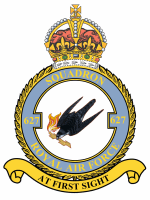
No. 578 Squadron RAF was a heavy bomber squadron of the Royal Air Force during the Second World War.
No. 640 Squadron RAF was a heavy bomber squadron of the Royal Air Force during the Second World War.
No. 635 Squadron RAF was a heavy bomber squadron of the Royal Air Force during the Second World War.
No. 622 Squadron RAF is a reserve aircrew squadron of the Royal Auxiliary Air Force. During World War II, it operated as a bomber squadron of the Royal Air Force. Post-war it served shortly as a transport squadron in the RAuxAF.

No. 619 Squadron RAF was a heavy bomber squadron of the Royal Air Force during the Second World War, flying Lancaster bombers from bases in Lincolnshire.

No. 514 Squadron RAF was a bomber squadron of the Royal Air Force during the Second World War.
No. 692 Squadron RAF was a light bomber squadron of the Royal Air Force during the Second World War.
No. 625 Squadron RAF was a heavy bomber squadron of the Royal Air Force during the Second World War.
No. 582 Squadron RAF was a bomber pathfinder squadron of the Royal Air Force during the Second World War.
No. 626 Squadron RAF was a heavy bomber squadron of the Royal Air Force from 1943 to 1945.

No. 358 Squadron RAF was a Bomber and Special duties squadron of the Royal Air Force flying with South East Asia Command from 1944 to 1945.

No 620 Squadron was a squadron of the Royal Air Force during World War II. During its existence it served as a bomber squadron, airborne forces and a transport squadron.
No. 61 Squadron was a squadron of the Royal Air Force. It was first formed as a fighter squadron of the British Royal Flying Corps during the First World War. It was reformed in 1937 as a bomber squadron of the Royal Air Force and served in the Second World War and afterwards into the jet age, until disbanded in 1958.
No. 158 Squadron RAF was a World War I proposed ground attack squadron that did not become operational in time to see action, and a World War II bomber squadron. After World War II had ended in Europe the squadron operated in the transport role until disbandment in December 1945.

No. 576 Squadron RAF was a Royal Air Force Second World War heavy bomber squadron.

No. 550 Squadron RAF was a heavy bomber squadron of the Royal Air Force during World War II. Formed at RAF Waltham on 25 November 1943, 550 Squadron flew Avro Lancaster bombers as part of No. 1 Group RAF. In early 1944, the squadron was moved to RAF North Killingholme, Lincolnshire where it continued operations until May 1945, when it began dropping food over the Netherlands as a relief effort as part of Operation Manna. The squadron was disbanded on 31 October 1945. Today, a surviving Lancaster bomber continues to fly in the markings of BQ-B "Phantom of the Ruhr" EE139 from 550 squadron as part of the Battle of Britain Memorial Flight.
No. 571 Squadron RAF was a Second World War Royal Air Force pathfinder squadron operating the de Havilland Mosquito.

No. 103 Squadron was a Royal Air Force bomber squadron during World War I, World War II and the Cold War, switching to helicopters in the late 1950s until it was disbanded for the last time in 1975.
No. 524 Squadron was a Royal Air Force Coastal Command aircraft squadron that operated during the Second World War.

No. 627 Squadron was a Royal Air Force Mosquito aircraft pathfinder bomber squadron that operated during the Second World War.










